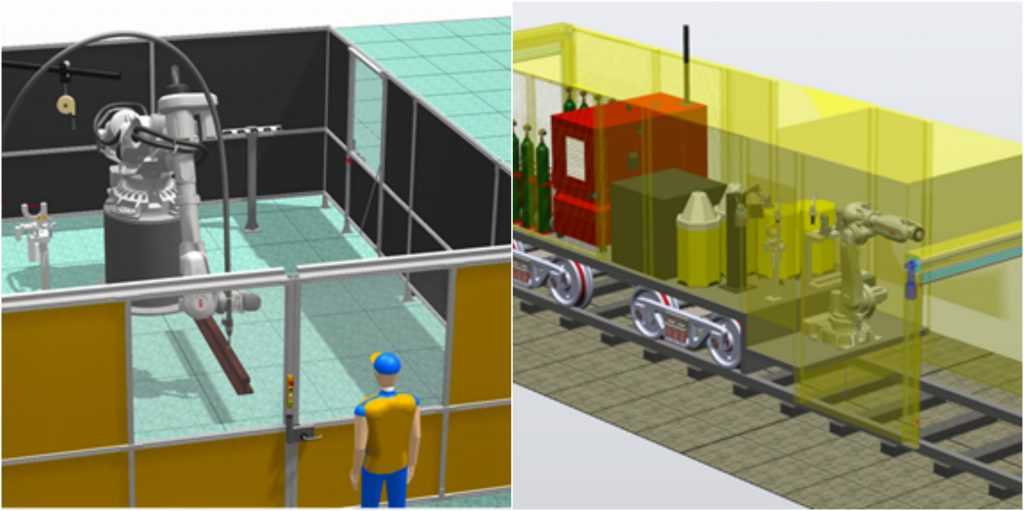Amey, a UK-based infrastructural support service provider, has revealed internal plans for applying 3D printing to train-track renewal. With concept drawings provided by Swiss robotic arm manufacturer ABB, the company demonstrates the construction of an independent repair carriage, capable of moving along railway lines and removing and replacing faults. Though still in its early stages, the company estimates that over 60% of UK railway lines could be refurbished using such a system, returning material economy and efficiency savings equating to over £40 million a year.
“At Amey, we’re exploring the use of 3D printing in the rail sector, beginning with track renewals,” Simon Grundy, Innovation Manager, Consulting & Rail at Amey, writes.
“3D printing will fundamentally change how we conduct track renewals.”
Robots on the railways – the benefits
Amey was founded in 1921 as a quarry operator. Growing during the second world war, the company helped in the construction of Royal Air Force bases. It is now a subsidiary of Spanish multinational transport company Ferrovial.
Since 2018, Amey has held rail repair and construction contracts for Network Rail, covering the East Midlands, London and the North West of the UK. Under growing demand, passengers for these services have reportedly doubled over the past 20 years. Though footfall has changed, much of the UK’s existing railway lines remain the same, and networks are now under increasing pressure to update transport infrastructure to better cater to the needs of the public. This, at present, requires significant manual labor.
“The 190,000 people working on the UK’s railways go above and beyond to ensure that the network is kept running,” writes Grundy, “However, every second they are on the tracks, they are at risk.” One possible solution to protect the workforce, and to rapidly fulfill repair demands, is in-situ robotic 3D printing. “Not only will this dramatically reduce accidents,” Grundy maintains, “the same staff will be upskilled to operate this new technology, future-proofing our workforce.”
Passengers are also expected to benefit from such a system, as the robotic system would work more quickly and efficiently, leading to shorter refurbishment times. “The main advantage is the reduction in time required, enabling smaller sections to be refurbished in smaller windows, ensuring the rail is open for longer,” Grundy adds, “In the future, light refurbishment could be conducted on a regular basis, changing the business model entirely.
3D printed, in-situ repair
Amey’s development of an in-situ robotic 3D printing unit is currently focused on the repair and refurbishment of switches and crossings, “an asset particularly prone to high levels of wear and one of the most vital pieces of infrastructure on our railway,” Grundy notes. “The project brings together state of the art technologies, from metrology to inspect the railroad’s current state, to adaptive and automated material removal, to remove old track.”
In one concept diagram, an ABB robotic arm is pictures inside a walled enclosure, picking up and moving a large segment of track. In the second diagram, a smaller robotic arm is pictured inside a railway carriage, equipped with machinery and gas canisters. This second diagram propose a system within which metal could be deposited onto broken track segments. The company also expects to be able to achieve large-scale additive manufacturing in this project, to fix meters-long segments of track in one go.
The vision is that non-destructive testing (NDT) would be applied to test depositions of 3D printed rail repair, “storing vital data on the new track, crucial to future maintenance,” Grundy adds.

A growing opportunity for AM
Though a challenging project, Amey’s 3D printed rail concept is not unprecedented. With large scale technologies like WAAM and EBAMM being applied in aerospace and maritime industries, the means to achieve this concept are there. Elsewhere, American multinational engineering firm AECOM is also applying 3D printing to the modernization of transport networks. Testing a Bristol Parkway, the company has developed a 3D printed arch that could be used to install new, digital signalling equipment. For British rolling stock operating company (ROSCO) Angel Trains, 3D printing is being integrated as a means of spare part supply. For Angel Trains partner Stratasys, the rail industry as a whole has become a significant area of opportunity following a lull in automotive investment.
“This is a challenge unlike any other,” Grundy concludes, “yet confidence is growing at a staggering rate as this technology becomes understood and realization dawns that the components needed, exist today.”
Please subscribe to the 3D Printing Industry newsletter, follow us on Twitter and like us on Facebook. Seeking jobs in engineering? Make your profile on 3D Printing Jobs, or advertise to find experts in your area.
Featured image shows Amey’s robotic 3D printing rail refurbishment concepts. Image via ABB



